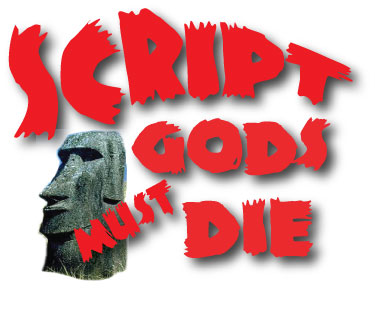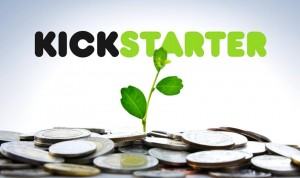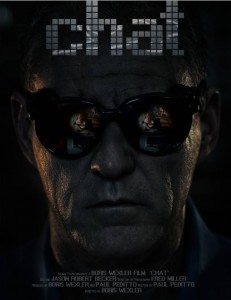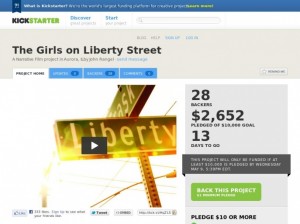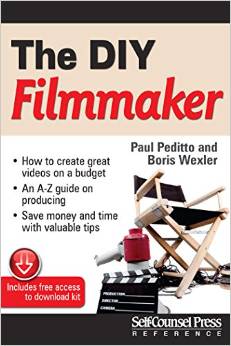Funded!
Beautiful word, is it not?
As I write this here is where we stand with our Kickstarter campaign for CHAT:
198 BACKERS
$25,436 PLEDGED OF $25,000 GOAL
22 HOURS TO GO
This is not 100% of our budget by any means. But it’s a significant chunk. Without this $25,000, no way the project happens.
How did we get funded? While I’m in no way a Kickstarter expert, I probably have an insight or two that might help you, Good Reader, so let’s look over the anatomy of the thing, how we got to 25K, and how you might do the same.
- Assemble a team
Critical first step. You need to find people who are invested, who will not flake out. People who are realistic about the time they can commit and then deliver on their word. That last part being the true dilemma—how do you know in advance is someone will be a flake or not? Eternal thanks to Lucy, Jessica and Brian for putting in hours of their lives for zero up front money because they believe in the project. You are true nature’s noblemen! So, once you’ve got the soldiers for the campaign…
- Conceive the plan
It’s in the earliest meetings that you’ll divide up responsibilities. Establish a framework of expectations and the timetable to get things done. The Video Pitch has to be written and shot. The accompanying Text Pitch has to be written. The Gifts for each price level have to be conceived, written and probably rewritten. Then there’s the little matter of brainstorming EVERY LIVING PERSON YOU’VE EVER KNOWN in preparation for a personalized email or Facebook message. The hat is about to be passed.
- The Video Pitch
We had the idea that we would use a test scene we shot as a trailer for how the movie might look. It’s a great looking scene (that cost all of $200 to shoot) and was an excellent teaser…the only problem? SAG issues (they wanted $800 for the use of a SAG actor) forced us to go a different way. I wrote a quick one minute mini-scene in the vein and tone of the story, followed by a 90 second director pitch given artfully by my ever-charming, ever-French partner Boris Wexler. We shot the video of the actress and her one minute “scene”, plus the Boris material, in two days. Then we edited in whatever we could to make it visual—pick up street video with our 5D, stills from the script and test scene—then edited everything to a sub-3 minute pitch….
- Text Pitch
To accompany the video pitch is the text, which tells the world of the project, informs on what you’re goals and dreams are, on what their money might be used for, and gives a sense of the passion you’re bringing for the project. If you can’t instill that passion into this text, I’d suggest you set your goal REALLY low—because you likely won’t make it. Too many people out there with too much passion for their projects. Look through the scores of projects either funded or nearly funded for inspiration on what the text should look like. Kickstarter is the place where folks gather who have no intention of begging for entrance to Paramount’s front gate. They are not going to be told no by the L.A. gated-community 1%ers. Let Hollywood zig with TRANSFORMERS and BATTLESHIP, we’ll just zag and zag and zag our projects into greenlight status without your fucking approval! Ok, back off my soap box…
- Gifts
This was a tricky one to write. For each accompanying price level the donors should get a prize. You’ll need to pick a price point to start awarding gifts (Kickstarter allows $1 contributions; we started our gifts at the $10 range). Traditional gifts of DVD’s, t-shirts, and posters, on up to mention in the credit roll or with IMDB. Finds way to be creative in gift-giving that speaks specifically of your project. CHAT is about adult internet chat so the gifts might be racy. For instance at $100 you get a sexy voice mail from the lead actress. For $250 you get a prop from the movie. $750 actually gets you ON the set as a walk-on extra part, or allows you to name the pet mouse of the lead character. See? Bring your audience in on your process immediately. Get them rooting for you to be funded, get them TALKING about you on Facebook and other social media. Generate a buzz ASAP.
- The Personalize Email
Almost certainly the most important part of the entire process. You need to go from A to Z on your Google G-mail list and write a personal letter to EVERY PERSON WHO MIGHT DONATE. No, you cannot write a form letter and mass mail out! You have an inner circle that MUST come through as backers of your project. This process will take hours upon hours but should give you a good base toward attaining your goal. Lock up friends and family first; get the Kickstarter campaign off to a FAST start with Mom’s money in the first 48 hours, then work toward good friends, then on back to decent friends, acquaintances, then the Shell Station attendant on Western Avenue who struck up a conversation with you last Christmas.
Ok, if you’re down the Shell Station guy, it doesn’t have to be personalized, but make no mistake…this plea will pretty much determine whether your project happens, so make this email a good one!
- Social Media
Needless to say you’re going on Facebook for this campaign. You must. You need to find a balance between awareness and spam. Once a day was enough for me because I had planted our movie idea with other folks who then linked to our campaign and broadcast it themselves. That’s how friends can help if they’re broke…AWARENESS. The more your project is out there on multiple social media platforms, obviously, the better. The goal is to bring in that mythical creature into your project—the lurker. Someone no one on your team knows. Kickstarter admits that the vast majority of money raised is directly through friends and family, but occasionally if the campaign is visually compelling or strikes a chord, you will get people you don’t know to contribute. The old “first 10 pages” of the script is out the door here. If the first 30 seconds of your video aren’t visually compelling, you can pretty much kiss off any lurker money. Meanwhile, hit up your Facebook friends, all of them if possible. I developed a short four-line message pitch for people on my list I hadn’t hit with the G-mail pitch. Turn every stone.
- Updates
It’s standard knowledge that updates are critical. Stay in touch with your donors. Let them know what’s happening with the project. Keep them abreast on progress with the goal, maybe new talent or locations found. Develop an emotional bond, have them rooting for the project to happen.
- David Letterman’s Top 12 Kickstarter Secrets
Kidding…
These come from my friend and fellow Columbia compadre John Rangel, who has successfully funded several Kickstarter campaigns, found here.
1 – Give before you get – the more you support other projects the more they’ll support you. Beyond giving money, what you can give them is shares/tweets to broaden their reach. Then, when your project starts they can’t wait to spread the word for you.
2 – Reasonable goal amount – do a hard estimate of what you can raise and shoot for that amount. Don’t go pie in the sky – that’s a sure-fire way to fall short of your goal.
3 – 30 days – go beyond that and you’ll have too many people completely forget about your campaign and you’ll get fatigue from pushing it. Any shorter than that and you don’t get sufficient time to broaden your reach.
4 – Rewards – keep these low cost, reasonable to create but add a personal touch. Offer something you can give them that’s unique and speaks to your appreciation.
5 – Video – personal appeal always wins. The creators speaking directly to the camera are best. Tell them exactly what you’ll do with the money. Remember, people are giving to YOU, not your project. That’s the way they see it.
6 – Daily management – crowdsourcing is a day by day and hour to hour effort. You can’t start it and forget about it, hoping to come back with a bunch of cash waiting for you. You should tweet/post a couple times per hour during waking hours.
7 – Strategy – notify everyone of the campaign at hour one. Set daily goals to reach a certain number of backers. For example, tweet: Help us reach our goal of adding 10 backers today. Then, tweet every time a new backer contributes, thanking them and noting progress towards the day’s goal. This way, you’re asking people to click buttons, not give money. Keep the focus on the number of backers and people will forget about the big scary number you’re trying to raise.
8 – Backers as collaborators – when you post comments on your campaign’s page, ask your backers once a week to help spread the word. Then, if push comes to shove and you’re getting close to not reaching the goal, ask them to increase their contributions during the last week. Then, if someone giving $10 turns that into $20, immediately tweet “So and so just DOUBLED her contribution!”.
9 – Voice – your campaign needs to have a consistent and sincere voice. Personality matters. You can’t ask for money with a sledgehammer.
10 – Campaign updates – update your campaign page whenever possible. Add content – a new video of your director, new location scout video, rehearsals, actors who’ve been cast, etc. Give your backers the shared experience and they invest in your success. It’s no longer just your movie, it’s OUR movie.
11 – Twitter is your best friend – get cozy. In between tweets about goals and backers, tweet updates about the movie or just your usual shit – opinions, links, etc. Feel free to start conversations using your posts and tweets. Overall, backers want to see you succeed while getting a peek behind the curtain.
12 – Kickstarter vs Indiegogo – the recent press says Indiegogo hands down. You get whatever money you raise no matter what. KS is a brand name and that counts for something but Indiegogo is just as good functionally.
Look for more on CHAT coming up! Meanwhile….
